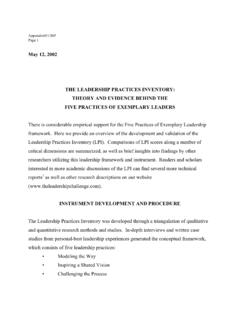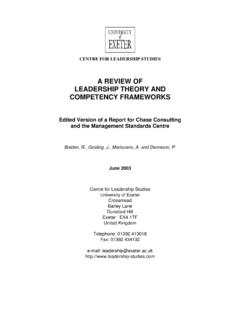Transcription of the leadership theory of robert K. greenleaf - Carol Smith
1 Smith 1 S e r v a n t l e a d e r s h i p : t h e l e a d e r s h i p t h e o r y o f r o b e r t K . g r e e n l e a f Carol Smith Info 640 mgmt. of info. Orgs. Submitted december 4, 2005 Smith 2 TABLE OF CONTENTS ABSTRACT 3 AUTHOR KEYWORDS: 3 SERVANT leadership theory 3 Defining Servant- leadership 3 Servant- leadership Attributes 5 Role of Values in Servant- leadership 6 theory Criticism 7 theory Support 8 theory Comparisons 9 robert K. greenleaf 10 Roots of Servant- leadership A Brief Biography 10 Publication of The Servant as Leader 11 Other Publications 11 theory APPLICATION 12 Scenario 13 Enter the Aspiring Servant-Leader 13 CONCLUSION 15 BIBLIOGRAPHY 16 Cover image credit: The greenleaf Centre for Servant- leadership UK (2005).
2 Retrieved November 12, 2005 from Smith 3 ABSTRACT Servant- leadership , first proposed by robert K. greenleaf in 1970, is a theoretical framework that advocates a leader s primary motivation and role as service to others. This paper defines and explores the central tenets of servant- leadership theory , and reviews the attributes and values displayed in exemplary servant-leaders. Academic criticism and support of the theory is reviewed, and servant- leadership is evaluated in terms of transformational leadership , a related framework. robert K. greenleaf s life and publications are also reviewed. The paper concludes with a fictional application of servant- leadership within an information organization. Servant- leadership is found to be a theory well suited for the information services arena, but one which still requires formalization, substantiation, and further research.
3 AUTHOR KEYWORDS: leadership theories; Servant- leadership ; greenleaf , robert K. (1904-1990). SERVANT leadership theory ..The great leader is seen as servant robert K. greenleaf This short quotation, a fragment of a sentence from an essay written in 1970, captures the essence of servant- leadership theory . A simple, yet profound and powerful concept, it has spawned countless journal articles, books and multimedia productions in the 35 years since its introduction. From humble roots, servant- leadership has gained increasing interest in recent decades, and is now extensively applied in the workplace, demonstrating its potential as a practical, as well as theoretical approach to organizational management.
4 Defining Servant- leadership The very notion of a servant as leader, or servant- leadership as it has come to be known, is purposefully oxymoronic and arresting in nature. The theory s originator, robert K. greenleaf , intentionally sought a descriptor that would give people pause for thought, and challenge any long-standing assumptions that might be held about the relationship between leaders and followers in an organization. By combining two seemingly contradictory terms, greenleaf asks us to reconsider the very nature of leadership . Although aware of the negative historical connotations associated with the word servant , he felt it a necessary choice to turn established conceptions about the organizational pyramid on their head, and jump-start insight into a new view of leadership .
5 This concern for linguistic impact is further evidenced by the greenleaf s titling of his seminal essay as The Servant as Leader , and not the inverse, The Leader as Servant . Smith 4 Larry Spears, Executive Director of the robert K. greenleaf Center for Servant- leadership , succinctly defines servant- leadership as: ..A new kind of leadership model a model which puts serving others as the number one priority. Servant- leadership emphasizes increased service to others; a holistic approach to work; promoting a sense of community; and the sharing of power in decision-making (1996, p. 33). Each of these central tenets is explored individually below, to present a fuller picture of the servant- leadership framework.
6 1. Service to Others. Servant- leadership begins when a leader assumes the position of servant in their interactions with followers. Authentic, legitimate leadership arises not from the exercise of power or self-interested actions, but from a fundamental desire to first help others. greenleaf wrote that this simple fact is the key to [a leader s] greatness (1970, p. 2). A servant-leader s primary motivation and purpose is to encourage greatness in others, while organizational success is the indirect, derived outcome of servant- leadership . 2. Holistic Approach to Work. Servant- leadership holds that The work exists for the person as much as the person exists for the work ( greenleaf , 1996, p. 8). It challenges organizations to rethink the relationships that exist between people, organizations and society as a whole.
7 The theory promotes a view that individuals should be encouraged to be who they are, in their professional as well as personal lives. This more personal, integrated valuation of individuals, it is theorized, ultimately benefits the long-term interests and performance of the organization. 3. Promoting a Sense of community. greenleaf lamented the loss of community in modern society, calling it the lost knowledge of these times (1970, p. 28). Servant- leadership questions the institution s ability to provide human services, and argues that only community, defined as groups of individuals that are jointly liable for each other both individually and as a unit, can perform this function. Only by establishing this sense of community among followers can an organization succeed in its objectives.
8 Further, the theory posits that this sense of community can arise only from the actions of individual servant-leaders ( greenleaf , 1970, p. 30). 4. Sharing of Power in Decision-Making. Effective servant- leadership is best evidenced by the cultivation of servant- leadership in others. By nurturing participatory, empowering environments, and encouraging the talents of followers, the servant-leader creates a more effective, motivated workforce and ultimately a more successful organization. As phrased by Russell (2001), Leaders enable others to act not by hoarding the power they have but by giving it away (p. 80). The organizational structure resulting from servant- leadership has sometimes been referred to as an inverted pyramid , with employees, clients and other stakeholders at the top, and leader(s) at the bottom.
9 Exemplary followers, a product of delegated decision-making, are a further example of servant- leadership s inverse nature, another type of leader turned inside out (Sarkus, 1996, p. 28). Because servant- Smith 5 leadership breaks away from the classic organizational pyramid and promotes flexible, delegated organizational structures, many behavioral scientists see it as a forward-looking, post-industrial paradigm for leadership (incl. Lee & Zemke, 1993; Biberman & Whitty, 1997). Servant- leadership Attributes Each of the above-listed tenets of servant- leadership can derive only from the selfless, others-directed motivation that resides within the leader. This foundation is distinctive to servant- leadership .
10 According to Smith , Montagno and Kuzmenko, Typically, models of leadership do not begin with an analysis of leader motivation, and greenleaf s concepts in this regard are unique (2004, p. 82). Accordingly, aspiring servant-leaders must first scrutinize their personal belief systems and reasons for aspiring to lead. Strong leader ethics, principles and values lie at the core of the theory , and are seen as being key to the long-term interests of the organization being served. Servant- leadership , therefore, emphasizes core personal characteristics and beliefs over any specific leadership techniques. This is seen throughout the writings of robert K. greenleaf , from his first, seminal essay on servant- leadership to his posthumously published writings.




